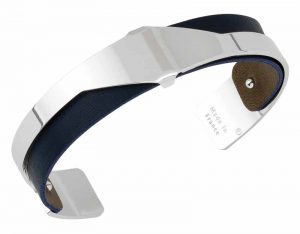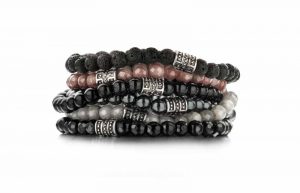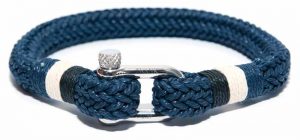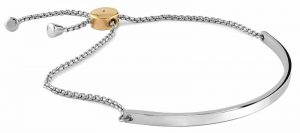Men of steel: Drawing in male customers with alternative materials
by carly_midgley | June 20, 2018 12:27 pm
By Dasha Moller
 [1]
[1]Retailers are seeing the growing opportunity in men’s apparel and accessories, especially when considering the statistics. According to a report from Euromonitor International, “menswear grew by four per cent in 2016, outpacing womenswear for the second consecutive year.” (For more, see the 2017 report, “New Apparel and Footwear Research Category Overview: Sportswear Maintains Momentum.” Visit blog.euromonitor.com/2017/01/new-apparel-and-footwear-research-category-overview-sportswear-maintains-momentum.html[2].)
A similar study from The New York Times notes “sales of men’s accessories grew nine per cent to US$13.6 billion in the 12 months ending May 2014, capping a two-year period that saw the category grow 13 per cent overall, according to the market research company NPD Group.” (More is online at www.nytimes.com/2014/09/12/fashion/jewelry-for-men-is-back-in-vogue.html[3].)
Euromonitor concludes, “men are showing more interest in their appearance and the latest fashions. As they become more willing to spend on fashion, retailers have turned quickly towards menswear.” (Learn more by consulting “Trends in the Men’s Fashion Market,” published by Euromonitor Research on March 30, 2015, and available at blog.euromonitor.com/2015/03/trends-in-the-mens-fashion-market.html[4].)
Men’s willingness to spend and high interest in fashion is fantastic for jewellery designers, manufacturers, and retailers alike, since a greater interest in clothing comes with stronger interest in accessories such as jewellery to complete the look. Alternative materials such as stainless steel are the perfect entry price point to make a fashion statement.
What’s out there for men?
 [5]
[5]Photo courtesy Frank 1967
Along with wedding bands, bracelets are driving sales in men’s fashion jewellery. For Frank 1967, a men’s jewellery brand, the highest percentage of sales are in bracelets. Within this category, sales are led by leather bracelets, followed by the bead bracelet, according to Gert-Jan Beukenkamp, general manager at Offenbach Group, which produces and distributes the brand.
“Men’s buying habits have moved beyond the traditional confines in jewellery, namely watches and wedding bands. There is more of an evident passion toward wristwear and bracelets, resulting in personal expression,” says Sam Mamane of men’s jewellery brand Italgem Steel. “Retailers must provide a wide selection of men’s jewellery, whether it be in traditional metals or in alternative materials such as leather and beads. Men now perceive jewellery as an extension of their lifestyle.”
Stainless steel style
 [6]
[6]Photo courtesy Italgem Steel
Traditionally, men’s jewellery (such as wedding bands, signet rings, and cufflinks) was primarily manufactured in precious metals, but stainless steel has become a rising star in the category. It provides benefits including durability, hypoallergenic properties, more accessible pricing, and style, according to Leonard Isayev, CEO of Kingsmen Ltd. (the Canadian distributor of watch brand Paul Hewitt and jewellery brand Les Georgettes, which recently launched a men’s line).
“The advantages of stainless steel jewellery, especially for men, are that it feels heavy and looks strong,” adds Beukenkamp. “It’s hassle-free in terms of quality, with very few plating or wear and tear issues. Hinges and other movable parts last very long, and most importantly, the platings stay for a very long time.”
Any plating in stainless steel is principally done by ion plating (IP), which generally proves longer-lasting than other metal plating techniques in fashion jewellery. IP is a physical vapour deposition (PVD) process and is a version of vacuum deposition. (This information is derived from en.wikipedia.org/wiki/Ion_plating[7].)
Mamane also notes stainless steel provides a more far affordable price point than gold and silver, as well as offering resistance to corrosion, rust, oxidation, and discolouration (and therefore greater return on investment [ROI]).
“It is also unplated in nature, which prevents fading and chipping over time while allowing the design to retain its shape more dutifully,” he says. “Lastly, it is an excellent alternative for those with allergies and sensitivities to base metals such as copper and brass.”
This metal’s resistance to rust and tarnish, hypoallergenic nature, and advantageous retail price point make it very attractive, especially to younger customers with more limited budgets and greater desire for diversity. The accessible price of stainless steel allows these consumers to try more different styles.
The stainless steel alloy most commonly used in jewellery is 316L (also known as surgical steel), because it contains low amounts of carbon and nickel. It is best suited for prolonged wear and body piercings.
Drawbacks of stainless steel
“One of the biggest cons of stainless steel jewellery is it is not a precious metal. Although stainless steel can ultimately achieve the same shine and look as other metals (like sterling silver, platinum, or gold), it does not encompass the same value,” says Mamane. “Some may find when gifting stainless steel jewellery, it does not convey the same message as precious metals.”
 [8]
[8]Photo courtesy Frank 1967
Isayev also says the metal can limit flexibility when it comes to making adjustments for comfort and size.
“It’s not a luxurious material, and it’s a heavier metal,” he says.
For example, stainless steel rings are difficult to resize compared to their precious metal counterparts, but as U.K. brand Man Up Jewellery points out on its website, the lower price point makes it easier to replace a stainless steel ring if required.
Leather details
 [9]
[9]Photo courtesy Frank 1967
Customers who wear leather watch straps and accessories (such as footwear) will likely appreciate leather jewellery. Generally, bovine (i.e. cow) leather is used in men’s jewellery, with braided or multistrand applications being popular. Although black and brown leather are standards in men’s jewellery, trendy colours such as navy blue, khaki, grey, burgundy, and tan brown are incorporated for novelty.
Leather can be a very enriching, highly beautiful natural material to work with, but it’s not for everyone. Awareness of customer values and purchasing habits can help jewellers adequately position leather products to their customer base. For instance, vegan leather is emerging in the fashion industry as an alternative to animal leather, but has yet to be introduced in the mass-market jewellery industry.
Leather bracelets, which are similar to leather watch straps, are likely the easiest product to start with.
“I would recommend using a similar rationale to how you would treat a watch with a leather strap,” says Isayev. “The benefit is the comfort and flexibility in colours and design.”
“Leather is an important component to use in men’s jewellery,” Beukenkamp argues. “It feels natural and blends perfectly with steel to get any specific look you strive for in your designs. However, it is a natural product, which means it can change in look and feel over time due to wear and tear.”
Leather products age over time, attaining a natural finish called patina, which gives the product a rustic and unique natural look. However, Isayev points out this aging process can also affect durability.
“Leather is not water-resistant and can damage when exposed to the elements,” he says.
Since leather is a natural material, it’s relevant to remind customers it should not be in direct contact with water, including swimming pools and fresh and saltwater. It’s also better to avoid direct heat such as saunas. These practical tips can help you avoid returns and complaints!
Pitfalls in men’s jewellery
 [10]
[10]Photo courtesy Italgem Steel
“I think manufacturing, design, and components are generally quite good in men’s jewellery, as it is designed to be more durable, but still have style,” says Isayev. “The shortcoming is a lack of the options and new creativity we see consistently in women’s jewellery.”
He notes the importance of offering products that incorporate creativity, customizability, and simplicity to excite customers. Yet, this isn’t the only consideration that should be made.
“Sizes of bracelets can be an issue, especially if you operate globally,” says Beukenkamp. “Of course, the design also needs to be adapted to fit in with local tastes and customs.”
On the upside, some stainless steel clasps on bracelets can be easily and quickly adjusted by goldsmiths, which can help during the sale and make inventory sizing more global.
What’s trending?
 [11]
[11]Photo courtesy Kingsmen Ltd./Les Georgettes
For men’s stainless steel jewellery specifically, trending items and techniques include:
- nautical inspirations such as anchor motifs and paracord material;
- natural themes such as feathers or animal- and reptile-inspired details;
- signet rings;
- smaller-sized, more proportionate pendants (e.g. military-style tags);
- keychains as gifting items;
- bangles (albeit in thinner width);
- gunmetal, blue IP finishing, and IP rose gold accents;
- matte finishing in IP;
- combination with leather or leather style in bracelets (especially braided or multistrand); and
- beaded bracelets or necklaces.
Don’t forget stainless steel can be engraved, which makes any jewel more personal and lifestyle-inspired for the customer. A lot of stainless steel jewels have rectangular-shaped buckles or pendants with ideal surfaces for engraving.
Getting started
Beukenkamp says demand for men’s jewellery is growing among younger generations.
“They want to look the part, and they will also be your customer when they need an engagement or wedding ring,” he says. “Make it known you do not only offer traditional jewellery, but also trendy jewellery for men of all ages. The key is to attract the new, young consumers—the millennials. They are more concerned with look and feel.”
“In reality, there is no typical male consumer,” adds Mamane. “It is more about the appreciation for the design.”
To increase sales in men’s jewellery, Isayev has a number of recommendations.
“Have a collection of great men’s brands that offer different options for different male consumers,” he says. “Also drive traffic to stores through social media and have a strong online presence.”
He also says it is crucial to ensure your collections are well spread out and easy for the customer to see, and stresses the importance of “telling a story with each collection.”
“It should fit well into the space to tell a strong, clear story,” he says.
Men’s jewellery is now on the rise, with the demographic’s increased willingness to spend and greater fashion interest fuelling demand. It’s time to celebrate this growing category (and especially jewellery with alternative materials)!
 [12]Dasha Moller is a jewellery professional who has recently returned to Canada after living in Europe for 20 years. With almost 15 years of experience in the jewellery industry, she has worked with a diverse range of jewellery portfolios, including women’s, men’s, and children’s jewellery, celebrity collections, and sports merchandising. Moller can be contacted via e-mail at dashamoller@gmail.com.
[12]Dasha Moller is a jewellery professional who has recently returned to Canada after living in Europe for 20 years. With almost 15 years of experience in the jewellery industry, she has worked with a diverse range of jewellery portfolios, including women’s, men’s, and children’s jewellery, celebrity collections, and sports merchandising. Moller can be contacted via e-mail at dashamoller@gmail.com.
- [Image]: https://www.jewellerybusiness.com/wp-content/uploads/2018/06/07K1187.jpg
- blog.euromonitor.com/2017/01/new-apparel-and-footwear-research-category-overview-sportswear-maintains-momentum.html: https://blog.euromonitor.com/2017/01/new-apparel-and-footwear-research-category-overview-sportswear-maintains-momentum.html
- www.nytimes.com/2014/09/12/fashion/jewelry-for-men-is-back-in-vogue.html: https://www.nytimes.com/2014/09/12/fashion/jewelry-for-men-is-back-in-vogue.html
- blog.euromonitor.com/2015/03/trends-in-the-mens-fashion-market.html: https://blog.euromonitor.com/2015/03/trends-in-the-mens-fashion-market.html
- [Image]: https://www.jewellerybusiness.com/wp-content/uploads/2018/06/Frank-1967-7FB_0090_b.jpg
- [Image]: https://www.jewellerybusiness.com/wp-content/uploads/2018/06/STTN10.jpg
- en.wikipedia.org/wiki/Ion_plating: https://en.wikipedia.org/wiki/Ion_plating
- [Image]: https://www.jewellerybusiness.com/wp-content/uploads/2018/06/Frank-1967-7FB-0045.jpg
- [Image]: https://www.jewellerybusiness.com/wp-content/uploads/2018/06/Frank-1967-7FB-0144.jpg
- [Image]: https://www.jewellerybusiness.com/wp-content/uploads/2018/06/SWB111.jpg
- [Image]: https://www.jewellerybusiness.com/wp-content/uploads/2018/06/07K1272.jpg
- [Image]: https://www.jewellerybusiness.com/wp-content/uploads/2018/06/Dasha-Moller-2017-High-Res.jpg
Source URL: https://www.jewellerybusiness.com/features/men-of-steel-drawing-in-male-customers-with-alternative-materials/